A Report on Psychographic and Behavioral Segmentation Techniques
VerifiedAdded on 2023/06/18
|8
|2581
|234
Report
AI Summary
This report provides a comprehensive analysis of psychographic and behavioral segmentation techniques in marketing, particularly within the tourism industry. It explores the strengths, limitations, effectiveness, and ease of application of each method. Psychographic segmentation focuses on understanding consumer lifestyles, values, and interests, while behavioral segmentation emphasizes consumer actions and purchasing behaviors. The report discusses how these segmentation strategies can be used to tailor marketing efforts, improve customer loyalty, and gain a competitive advantage. It concludes that a combination of both approaches is most effective for achieving long-term success and delivering personalized, high-quality services to customers. Desklib offers this solved assignment and other resources to support students in their studies.
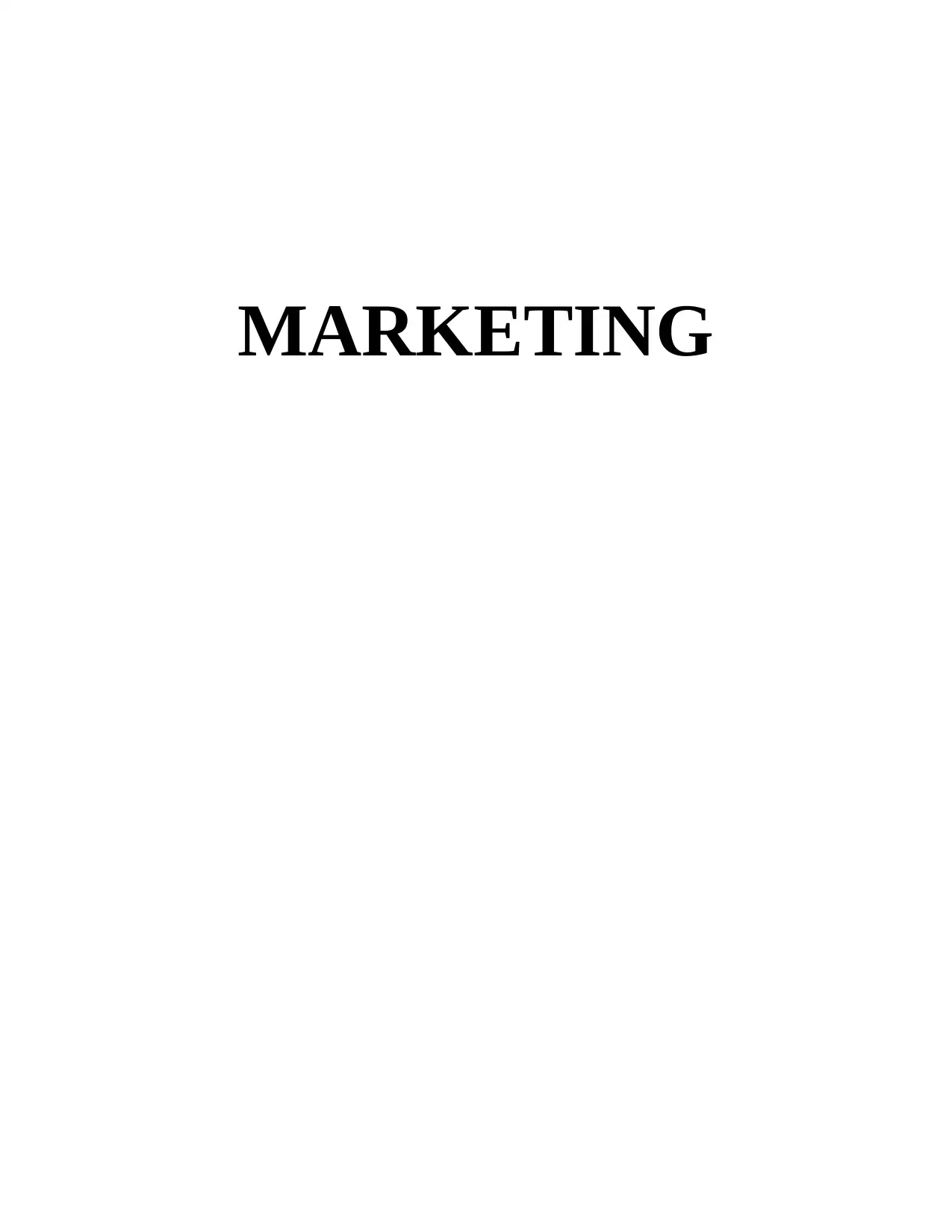
MARKETING
Paraphrase This Document
Need a fresh take? Get an instant paraphrase of this document with our AI Paraphraser
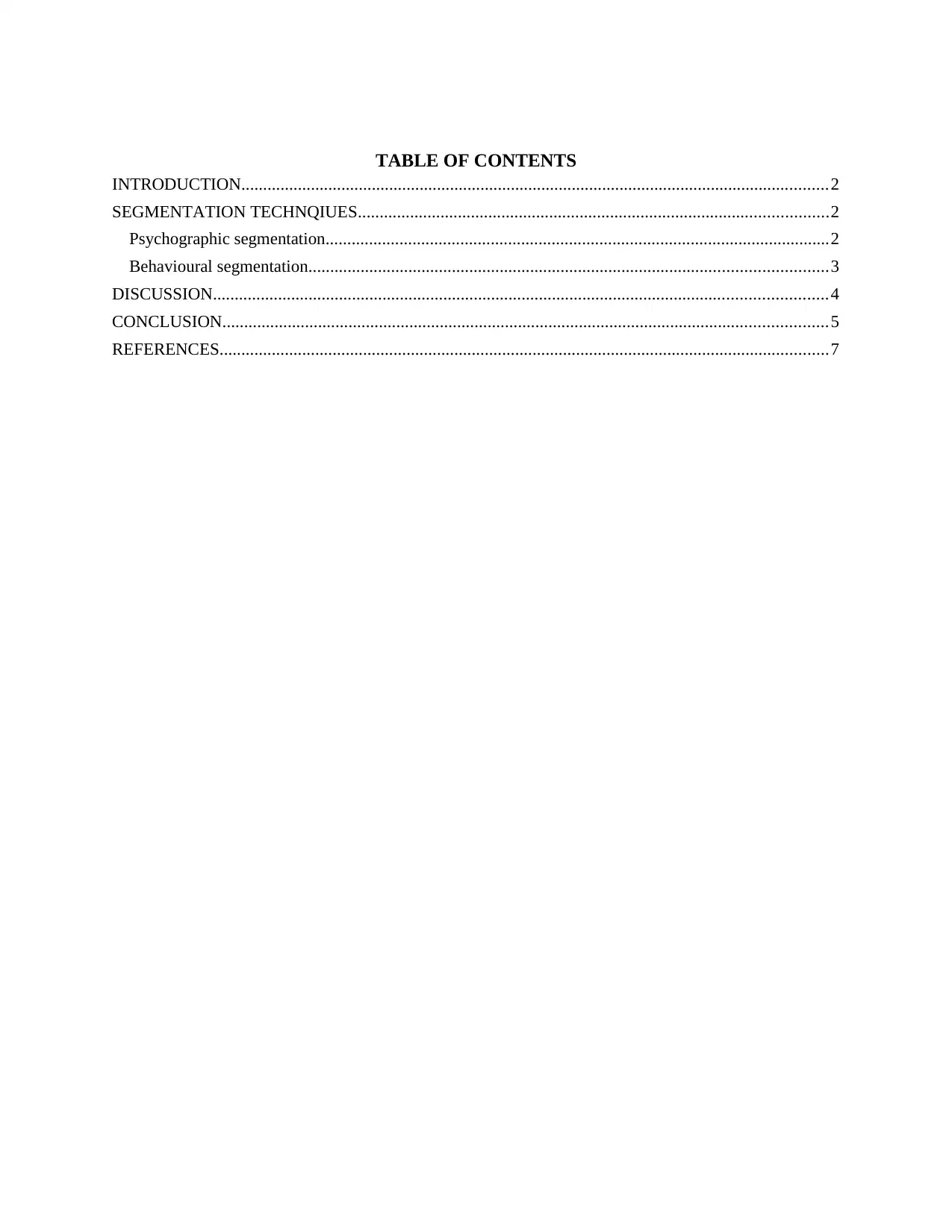
TABLE OF CONTENTS
INTRODUCTION.......................................................................................................................................2
SEGMENTATION TECHNQIUES............................................................................................................2
Psychographic segmentation....................................................................................................................2
Behavioural segmentation.......................................................................................................................3
DISCUSSION.............................................................................................................................................4
CONCLUSION...........................................................................................................................................5
REFERENCES............................................................................................................................................7
INTRODUCTION.......................................................................................................................................2
SEGMENTATION TECHNQIUES............................................................................................................2
Psychographic segmentation....................................................................................................................2
Behavioural segmentation.......................................................................................................................3
DISCUSSION.............................................................................................................................................4
CONCLUSION...........................................................................................................................................5
REFERENCES............................................................................................................................................7
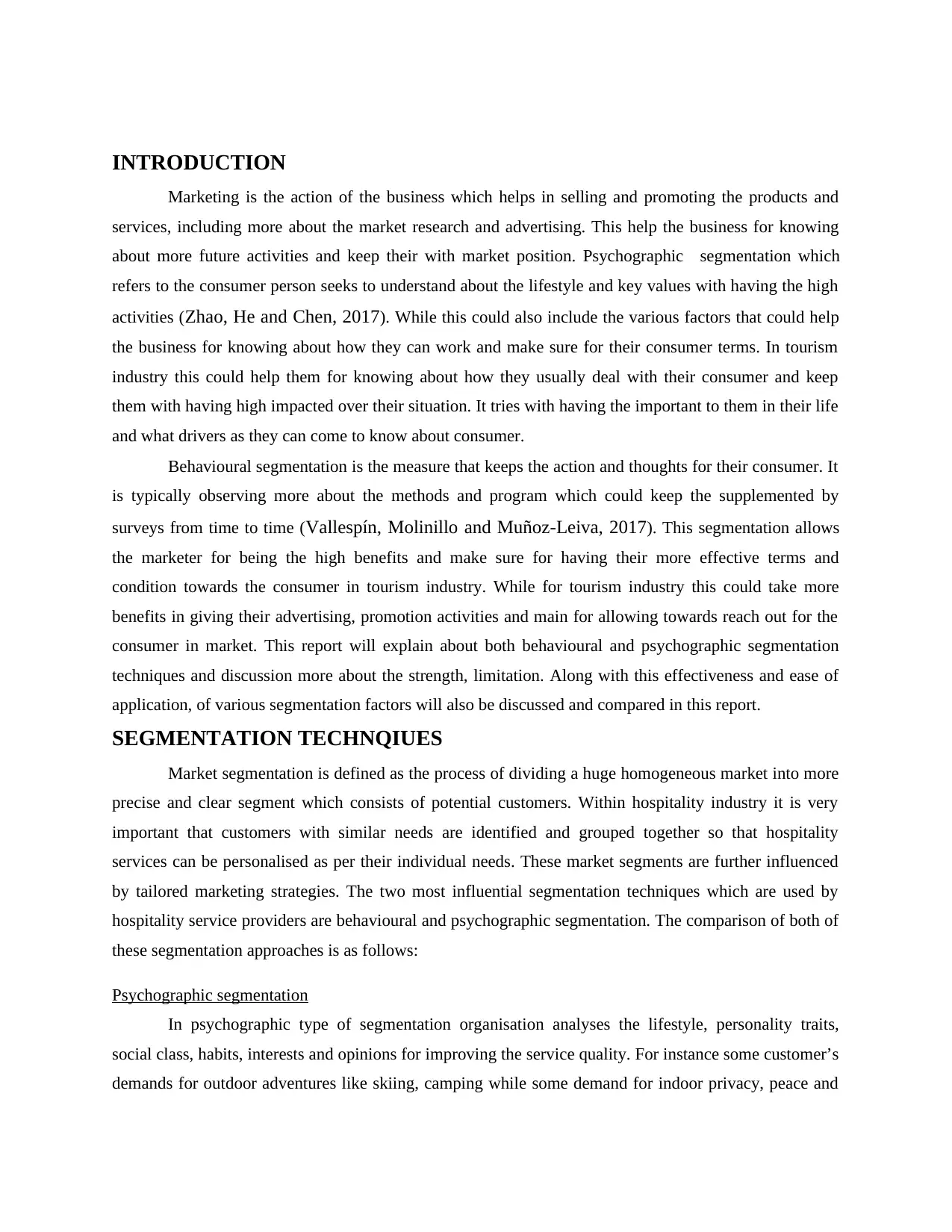
INTRODUCTION
Marketing is the action of the business which helps in selling and promoting the products and
services, including more about the market research and advertising. This help the business for knowing
about more future activities and keep their with market position. Psychographic segmentation which
refers to the consumer person seeks to understand about the lifestyle and key values with having the high
activities (Zhao, He and Chen, 2017). While this could also include the various factors that could help
the business for knowing about how they can work and make sure for their consumer terms. In tourism
industry this could help them for knowing about how they usually deal with their consumer and keep
them with having high impacted over their situation. It tries with having the important to them in their life
and what drivers as they can come to know about consumer.
Behavioural segmentation is the measure that keeps the action and thoughts for their consumer. It
is typically observing more about the methods and program which could keep the supplemented by
surveys from time to time (Vallespín, Molinillo and Muñoz-Leiva, 2017). This segmentation allows
the marketer for being the high benefits and make sure for having their more effective terms and
condition towards the consumer in tourism industry. While for tourism industry this could take more
benefits in giving their advertising, promotion activities and main for allowing towards reach out for the
consumer in market. This report will explain about both behavioural and psychographic segmentation
techniques and discussion more about the strength, limitation. Along with this effectiveness and ease of
application, of various segmentation factors will also be discussed and compared in this report.
SEGMENTATION TECHNQIUES
Market segmentation is defined as the process of dividing a huge homogeneous market into more
precise and clear segment which consists of potential customers. Within hospitality industry it is very
important that customers with similar needs are identified and grouped together so that hospitality
services can be personalised as per their individual needs. These market segments are further influenced
by tailored marketing strategies. The two most influential segmentation techniques which are used by
hospitality service providers are behavioural and psychographic segmentation. The comparison of both of
these segmentation approaches is as follows:
Psychographic segmentation
In psychographic type of segmentation organisation analyses the lifestyle, personality traits,
social class, habits, interests and opinions for improving the service quality. For instance some customer’s
demands for outdoor adventures like skiing, camping while some demand for indoor privacy, peace and
Marketing is the action of the business which helps in selling and promoting the products and
services, including more about the market research and advertising. This help the business for knowing
about more future activities and keep their with market position. Psychographic segmentation which
refers to the consumer person seeks to understand about the lifestyle and key values with having the high
activities (Zhao, He and Chen, 2017). While this could also include the various factors that could help
the business for knowing about how they can work and make sure for their consumer terms. In tourism
industry this could help them for knowing about how they usually deal with their consumer and keep
them with having high impacted over their situation. It tries with having the important to them in their life
and what drivers as they can come to know about consumer.
Behavioural segmentation is the measure that keeps the action and thoughts for their consumer. It
is typically observing more about the methods and program which could keep the supplemented by
surveys from time to time (Vallespín, Molinillo and Muñoz-Leiva, 2017). This segmentation allows
the marketer for being the high benefits and make sure for having their more effective terms and
condition towards the consumer in tourism industry. While for tourism industry this could take more
benefits in giving their advertising, promotion activities and main for allowing towards reach out for the
consumer in market. This report will explain about both behavioural and psychographic segmentation
techniques and discussion more about the strength, limitation. Along with this effectiveness and ease of
application, of various segmentation factors will also be discussed and compared in this report.
SEGMENTATION TECHNQIUES
Market segmentation is defined as the process of dividing a huge homogeneous market into more
precise and clear segment which consists of potential customers. Within hospitality industry it is very
important that customers with similar needs are identified and grouped together so that hospitality
services can be personalised as per their individual needs. These market segments are further influenced
by tailored marketing strategies. The two most influential segmentation techniques which are used by
hospitality service providers are behavioural and psychographic segmentation. The comparison of both of
these segmentation approaches is as follows:
Psychographic segmentation
In psychographic type of segmentation organisation analyses the lifestyle, personality traits,
social class, habits, interests and opinions for improving the service quality. For instance some customer’s
demands for outdoor adventures like skiing, camping while some demand for indoor privacy, peace and
⊘ This is a preview!⊘
Do you want full access?
Subscribe today to unlock all pages.

Trusted by 1+ million students worldwide
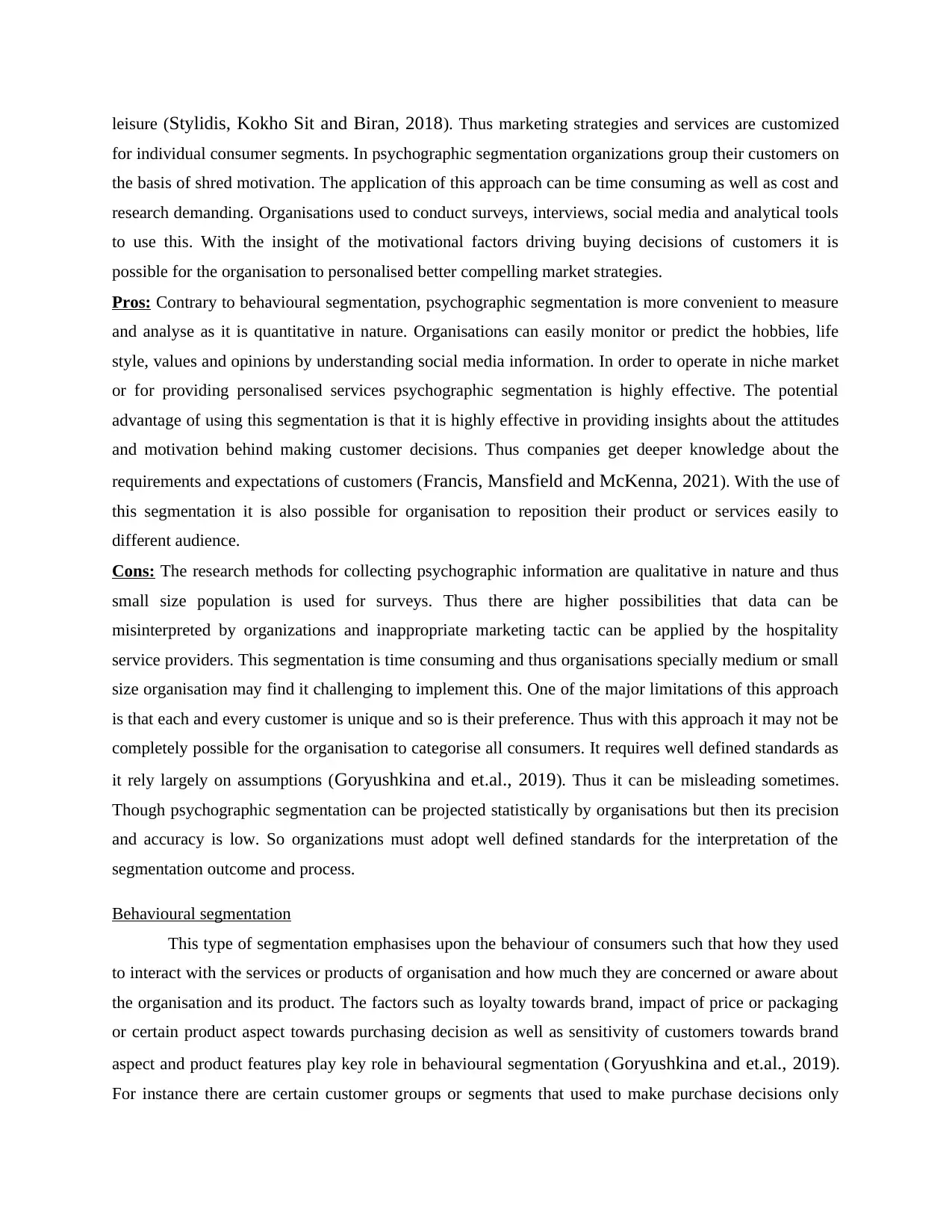
leisure (Stylidis, Kokho Sit and Biran, 2018). Thus marketing strategies and services are customized
for individual consumer segments. In psychographic segmentation organizations group their customers on
the basis of shred motivation. The application of this approach can be time consuming as well as cost and
research demanding. Organisations used to conduct surveys, interviews, social media and analytical tools
to use this. With the insight of the motivational factors driving buying decisions of customers it is
possible for the organisation to personalised better compelling market strategies.
Pros: Contrary to behavioural segmentation, psychographic segmentation is more convenient to measure
and analyse as it is quantitative in nature. Organisations can easily monitor or predict the hobbies, life
style, values and opinions by understanding social media information. In order to operate in niche market
or for providing personalised services psychographic segmentation is highly effective. The potential
advantage of using this segmentation is that it is highly effective in providing insights about the attitudes
and motivation behind making customer decisions. Thus companies get deeper knowledge about the
requirements and expectations of customers (Francis, Mansfield and McKenna, 2021). With the use of
this segmentation it is also possible for organisation to reposition their product or services easily to
different audience.
Cons: The research methods for collecting psychographic information are qualitative in nature and thus
small size population is used for surveys. Thus there are higher possibilities that data can be
misinterpreted by organizations and inappropriate marketing tactic can be applied by the hospitality
service providers. This segmentation is time consuming and thus organisations specially medium or small
size organisation may find it challenging to implement this. One of the major limitations of this approach
is that each and every customer is unique and so is their preference. Thus with this approach it may not be
completely possible for the organisation to categorise all consumers. It requires well defined standards as
it rely largely on assumptions (Goryushkina and et.al., 2019). Thus it can be misleading sometimes.
Though psychographic segmentation can be projected statistically by organisations but then its precision
and accuracy is low. So organizations must adopt well defined standards for the interpretation of the
segmentation outcome and process.
Behavioural segmentation
This type of segmentation emphasises upon the behaviour of consumers such that how they used
to interact with the services or products of organisation and how much they are concerned or aware about
the organisation and its product. The factors such as loyalty towards brand, impact of price or packaging
or certain product aspect towards purchasing decision as well as sensitivity of customers towards brand
aspect and product features play key role in behavioural segmentation (Goryushkina and et.al., 2019).
For instance there are certain customer groups or segments that used to make purchase decisions only
for individual consumer segments. In psychographic segmentation organizations group their customers on
the basis of shred motivation. The application of this approach can be time consuming as well as cost and
research demanding. Organisations used to conduct surveys, interviews, social media and analytical tools
to use this. With the insight of the motivational factors driving buying decisions of customers it is
possible for the organisation to personalised better compelling market strategies.
Pros: Contrary to behavioural segmentation, psychographic segmentation is more convenient to measure
and analyse as it is quantitative in nature. Organisations can easily monitor or predict the hobbies, life
style, values and opinions by understanding social media information. In order to operate in niche market
or for providing personalised services psychographic segmentation is highly effective. The potential
advantage of using this segmentation is that it is highly effective in providing insights about the attitudes
and motivation behind making customer decisions. Thus companies get deeper knowledge about the
requirements and expectations of customers (Francis, Mansfield and McKenna, 2021). With the use of
this segmentation it is also possible for organisation to reposition their product or services easily to
different audience.
Cons: The research methods for collecting psychographic information are qualitative in nature and thus
small size population is used for surveys. Thus there are higher possibilities that data can be
misinterpreted by organizations and inappropriate marketing tactic can be applied by the hospitality
service providers. This segmentation is time consuming and thus organisations specially medium or small
size organisation may find it challenging to implement this. One of the major limitations of this approach
is that each and every customer is unique and so is their preference. Thus with this approach it may not be
completely possible for the organisation to categorise all consumers. It requires well defined standards as
it rely largely on assumptions (Goryushkina and et.al., 2019). Thus it can be misleading sometimes.
Though psychographic segmentation can be projected statistically by organisations but then its precision
and accuracy is low. So organizations must adopt well defined standards for the interpretation of the
segmentation outcome and process.
Behavioural segmentation
This type of segmentation emphasises upon the behaviour of consumers such that how they used
to interact with the services or products of organisation and how much they are concerned or aware about
the organisation and its product. The factors such as loyalty towards brand, impact of price or packaging
or certain product aspect towards purchasing decision as well as sensitivity of customers towards brand
aspect and product features play key role in behavioural segmentation (Goryushkina and et.al., 2019).
For instance there are certain customer groups or segments that used to make purchase decisions only
Paraphrase This Document
Need a fresh take? Get an instant paraphrase of this document with our AI Paraphraser
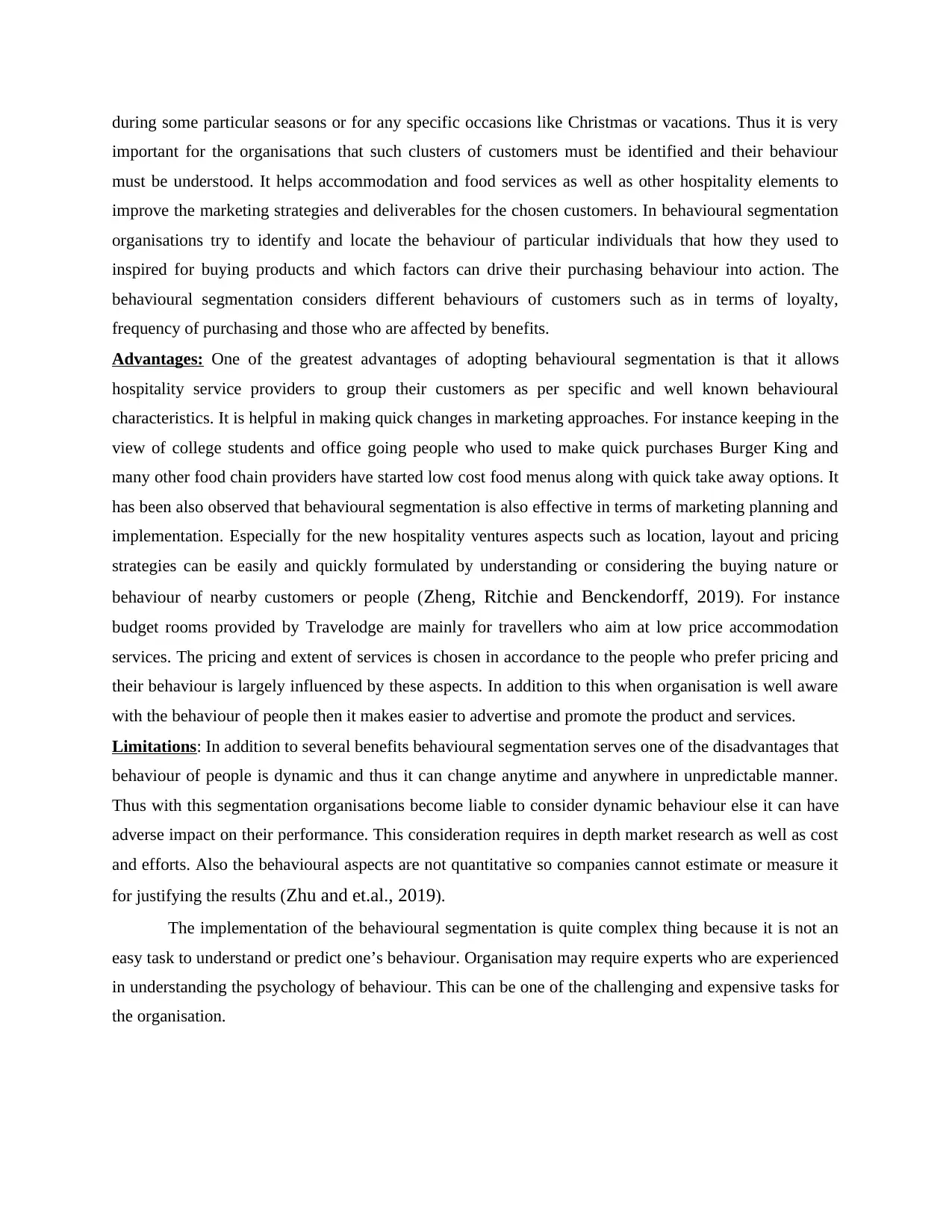
during some particular seasons or for any specific occasions like Christmas or vacations. Thus it is very
important for the organisations that such clusters of customers must be identified and their behaviour
must be understood. It helps accommodation and food services as well as other hospitality elements to
improve the marketing strategies and deliverables for the chosen customers. In behavioural segmentation
organisations try to identify and locate the behaviour of particular individuals that how they used to
inspired for buying products and which factors can drive their purchasing behaviour into action. The
behavioural segmentation considers different behaviours of customers such as in terms of loyalty,
frequency of purchasing and those who are affected by benefits.
Advantages: One of the greatest advantages of adopting behavioural segmentation is that it allows
hospitality service providers to group their customers as per specific and well known behavioural
characteristics. It is helpful in making quick changes in marketing approaches. For instance keeping in the
view of college students and office going people who used to make quick purchases Burger King and
many other food chain providers have started low cost food menus along with quick take away options. It
has been also observed that behavioural segmentation is also effective in terms of marketing planning and
implementation. Especially for the new hospitality ventures aspects such as location, layout and pricing
strategies can be easily and quickly formulated by understanding or considering the buying nature or
behaviour of nearby customers or people (Zheng, Ritchie and Benckendorff, 2019). For instance
budget rooms provided by Travelodge are mainly for travellers who aim at low price accommodation
services. The pricing and extent of services is chosen in accordance to the people who prefer pricing and
their behaviour is largely influenced by these aspects. In addition to this when organisation is well aware
with the behaviour of people then it makes easier to advertise and promote the product and services.
Limitations: In addition to several benefits behavioural segmentation serves one of the disadvantages that
behaviour of people is dynamic and thus it can change anytime and anywhere in unpredictable manner.
Thus with this segmentation organisations become liable to consider dynamic behaviour else it can have
adverse impact on their performance. This consideration requires in depth market research as well as cost
and efforts. Also the behavioural aspects are not quantitative so companies cannot estimate or measure it
for justifying the results (Zhu and et.al., 2019).
The implementation of the behavioural segmentation is quite complex thing because it is not an
easy task to understand or predict one’s behaviour. Organisation may require experts who are experienced
in understanding the psychology of behaviour. This can be one of the challenging and expensive tasks for
the organisation.
important for the organisations that such clusters of customers must be identified and their behaviour
must be understood. It helps accommodation and food services as well as other hospitality elements to
improve the marketing strategies and deliverables for the chosen customers. In behavioural segmentation
organisations try to identify and locate the behaviour of particular individuals that how they used to
inspired for buying products and which factors can drive their purchasing behaviour into action. The
behavioural segmentation considers different behaviours of customers such as in terms of loyalty,
frequency of purchasing and those who are affected by benefits.
Advantages: One of the greatest advantages of adopting behavioural segmentation is that it allows
hospitality service providers to group their customers as per specific and well known behavioural
characteristics. It is helpful in making quick changes in marketing approaches. For instance keeping in the
view of college students and office going people who used to make quick purchases Burger King and
many other food chain providers have started low cost food menus along with quick take away options. It
has been also observed that behavioural segmentation is also effective in terms of marketing planning and
implementation. Especially for the new hospitality ventures aspects such as location, layout and pricing
strategies can be easily and quickly formulated by understanding or considering the buying nature or
behaviour of nearby customers or people (Zheng, Ritchie and Benckendorff, 2019). For instance
budget rooms provided by Travelodge are mainly for travellers who aim at low price accommodation
services. The pricing and extent of services is chosen in accordance to the people who prefer pricing and
their behaviour is largely influenced by these aspects. In addition to this when organisation is well aware
with the behaviour of people then it makes easier to advertise and promote the product and services.
Limitations: In addition to several benefits behavioural segmentation serves one of the disadvantages that
behaviour of people is dynamic and thus it can change anytime and anywhere in unpredictable manner.
Thus with this segmentation organisations become liable to consider dynamic behaviour else it can have
adverse impact on their performance. This consideration requires in depth market research as well as cost
and efforts. Also the behavioural aspects are not quantitative so companies cannot estimate or measure it
for justifying the results (Zhu and et.al., 2019).
The implementation of the behavioural segmentation is quite complex thing because it is not an
easy task to understand or predict one’s behaviour. Organisation may require experts who are experienced
in understanding the psychology of behaviour. This can be one of the challenging and expensive tasks for
the organisation.
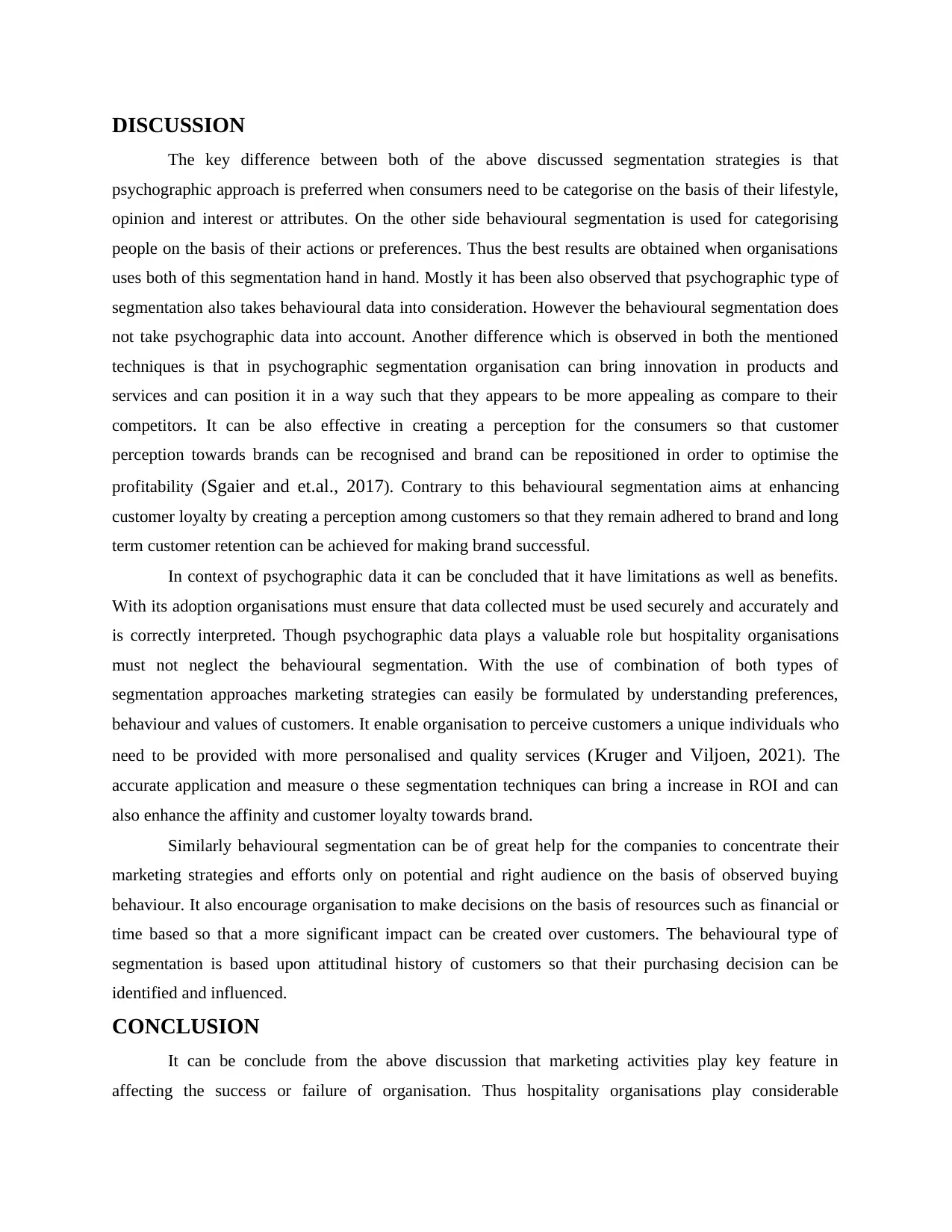
DISCUSSION
The key difference between both of the above discussed segmentation strategies is that
psychographic approach is preferred when consumers need to be categorise on the basis of their lifestyle,
opinion and interest or attributes. On the other side behavioural segmentation is used for categorising
people on the basis of their actions or preferences. Thus the best results are obtained when organisations
uses both of this segmentation hand in hand. Mostly it has been also observed that psychographic type of
segmentation also takes behavioural data into consideration. However the behavioural segmentation does
not take psychographic data into account. Another difference which is observed in both the mentioned
techniques is that in psychographic segmentation organisation can bring innovation in products and
services and can position it in a way such that they appears to be more appealing as compare to their
competitors. It can be also effective in creating a perception for the consumers so that customer
perception towards brands can be recognised and brand can be repositioned in order to optimise the
profitability (Sgaier and et.al., 2017). Contrary to this behavioural segmentation aims at enhancing
customer loyalty by creating a perception among customers so that they remain adhered to brand and long
term customer retention can be achieved for making brand successful.
In context of psychographic data it can be concluded that it have limitations as well as benefits.
With its adoption organisations must ensure that data collected must be used securely and accurately and
is correctly interpreted. Though psychographic data plays a valuable role but hospitality organisations
must not neglect the behavioural segmentation. With the use of combination of both types of
segmentation approaches marketing strategies can easily be formulated by understanding preferences,
behaviour and values of customers. It enable organisation to perceive customers a unique individuals who
need to be provided with more personalised and quality services (Kruger and Viljoen, 2021). The
accurate application and measure o these segmentation techniques can bring a increase in ROI and can
also enhance the affinity and customer loyalty towards brand.
Similarly behavioural segmentation can be of great help for the companies to concentrate their
marketing strategies and efforts only on potential and right audience on the basis of observed buying
behaviour. It also encourage organisation to make decisions on the basis of resources such as financial or
time based so that a more significant impact can be created over customers. The behavioural type of
segmentation is based upon attitudinal history of customers so that their purchasing decision can be
identified and influenced.
CONCLUSION
It can be conclude from the above discussion that marketing activities play key feature in
affecting the success or failure of organisation. Thus hospitality organisations play considerable
The key difference between both of the above discussed segmentation strategies is that
psychographic approach is preferred when consumers need to be categorise on the basis of their lifestyle,
opinion and interest or attributes. On the other side behavioural segmentation is used for categorising
people on the basis of their actions or preferences. Thus the best results are obtained when organisations
uses both of this segmentation hand in hand. Mostly it has been also observed that psychographic type of
segmentation also takes behavioural data into consideration. However the behavioural segmentation does
not take psychographic data into account. Another difference which is observed in both the mentioned
techniques is that in psychographic segmentation organisation can bring innovation in products and
services and can position it in a way such that they appears to be more appealing as compare to their
competitors. It can be also effective in creating a perception for the consumers so that customer
perception towards brands can be recognised and brand can be repositioned in order to optimise the
profitability (Sgaier and et.al., 2017). Contrary to this behavioural segmentation aims at enhancing
customer loyalty by creating a perception among customers so that they remain adhered to brand and long
term customer retention can be achieved for making brand successful.
In context of psychographic data it can be concluded that it have limitations as well as benefits.
With its adoption organisations must ensure that data collected must be used securely and accurately and
is correctly interpreted. Though psychographic data plays a valuable role but hospitality organisations
must not neglect the behavioural segmentation. With the use of combination of both types of
segmentation approaches marketing strategies can easily be formulated by understanding preferences,
behaviour and values of customers. It enable organisation to perceive customers a unique individuals who
need to be provided with more personalised and quality services (Kruger and Viljoen, 2021). The
accurate application and measure o these segmentation techniques can bring a increase in ROI and can
also enhance the affinity and customer loyalty towards brand.
Similarly behavioural segmentation can be of great help for the companies to concentrate their
marketing strategies and efforts only on potential and right audience on the basis of observed buying
behaviour. It also encourage organisation to make decisions on the basis of resources such as financial or
time based so that a more significant impact can be created over customers. The behavioural type of
segmentation is based upon attitudinal history of customers so that their purchasing decision can be
identified and influenced.
CONCLUSION
It can be conclude from the above discussion that marketing activities play key feature in
affecting the success or failure of organisation. Thus hospitality organisations play considerable
⊘ This is a preview!⊘
Do you want full access?
Subscribe today to unlock all pages.

Trusted by 1+ million students worldwide
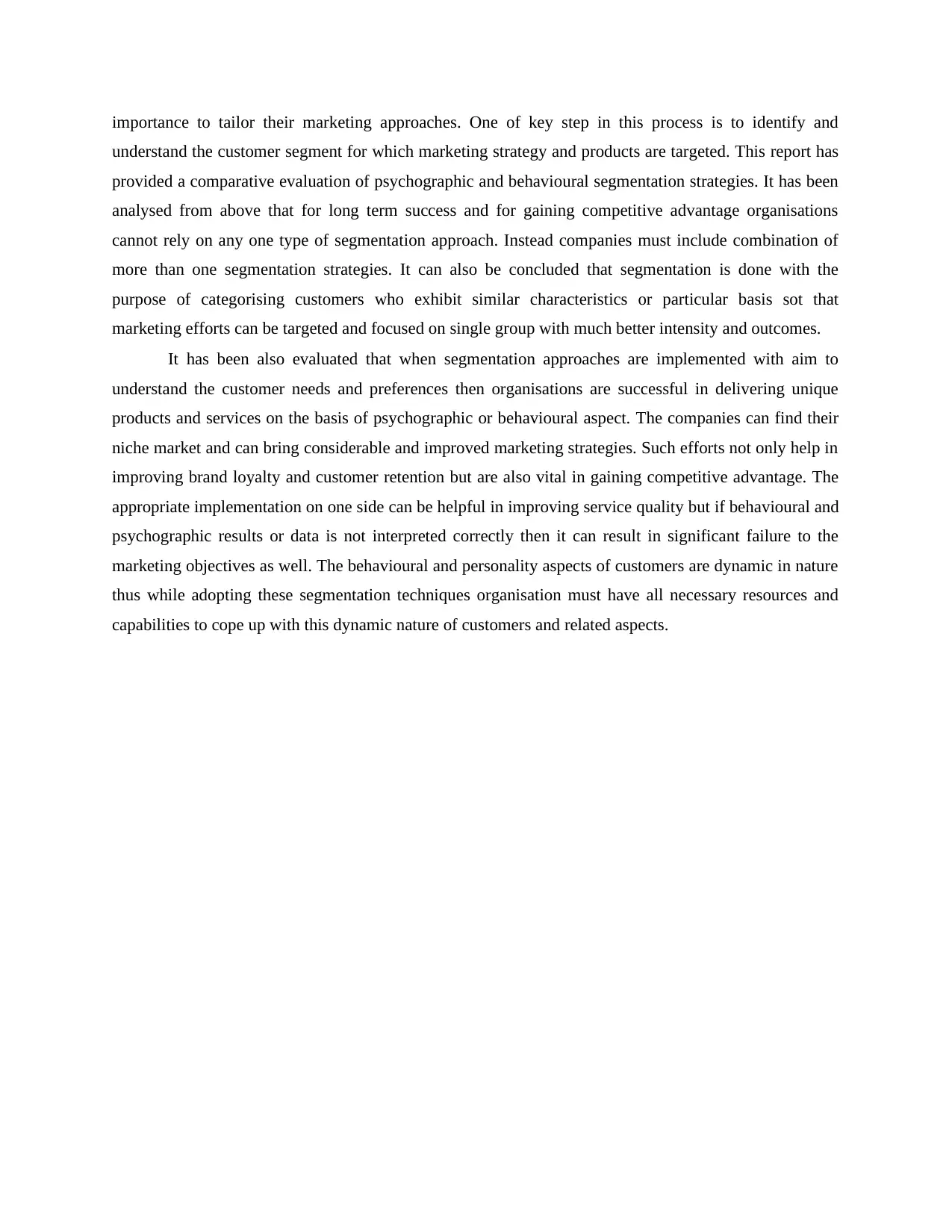
importance to tailor their marketing approaches. One of key step in this process is to identify and
understand the customer segment for which marketing strategy and products are targeted. This report has
provided a comparative evaluation of psychographic and behavioural segmentation strategies. It has been
analysed from above that for long term success and for gaining competitive advantage organisations
cannot rely on any one type of segmentation approach. Instead companies must include combination of
more than one segmentation strategies. It can also be concluded that segmentation is done with the
purpose of categorising customers who exhibit similar characteristics or particular basis sot that
marketing efforts can be targeted and focused on single group with much better intensity and outcomes.
It has been also evaluated that when segmentation approaches are implemented with aim to
understand the customer needs and preferences then organisations are successful in delivering unique
products and services on the basis of psychographic or behavioural aspect. The companies can find their
niche market and can bring considerable and improved marketing strategies. Such efforts not only help in
improving brand loyalty and customer retention but are also vital in gaining competitive advantage. The
appropriate implementation on one side can be helpful in improving service quality but if behavioural and
psychographic results or data is not interpreted correctly then it can result in significant failure to the
marketing objectives as well. The behavioural and personality aspects of customers are dynamic in nature
thus while adopting these segmentation techniques organisation must have all necessary resources and
capabilities to cope up with this dynamic nature of customers and related aspects.
understand the customer segment for which marketing strategy and products are targeted. This report has
provided a comparative evaluation of psychographic and behavioural segmentation strategies. It has been
analysed from above that for long term success and for gaining competitive advantage organisations
cannot rely on any one type of segmentation approach. Instead companies must include combination of
more than one segmentation strategies. It can also be concluded that segmentation is done with the
purpose of categorising customers who exhibit similar characteristics or particular basis sot that
marketing efforts can be targeted and focused on single group with much better intensity and outcomes.
It has been also evaluated that when segmentation approaches are implemented with aim to
understand the customer needs and preferences then organisations are successful in delivering unique
products and services on the basis of psychographic or behavioural aspect. The companies can find their
niche market and can bring considerable and improved marketing strategies. Such efforts not only help in
improving brand loyalty and customer retention but are also vital in gaining competitive advantage. The
appropriate implementation on one side can be helpful in improving service quality but if behavioural and
psychographic results or data is not interpreted correctly then it can result in significant failure to the
marketing objectives as well. The behavioural and personality aspects of customers are dynamic in nature
thus while adopting these segmentation techniques organisation must have all necessary resources and
capabilities to cope up with this dynamic nature of customers and related aspects.
Paraphrase This Document
Need a fresh take? Get an instant paraphrase of this document with our AI Paraphraser
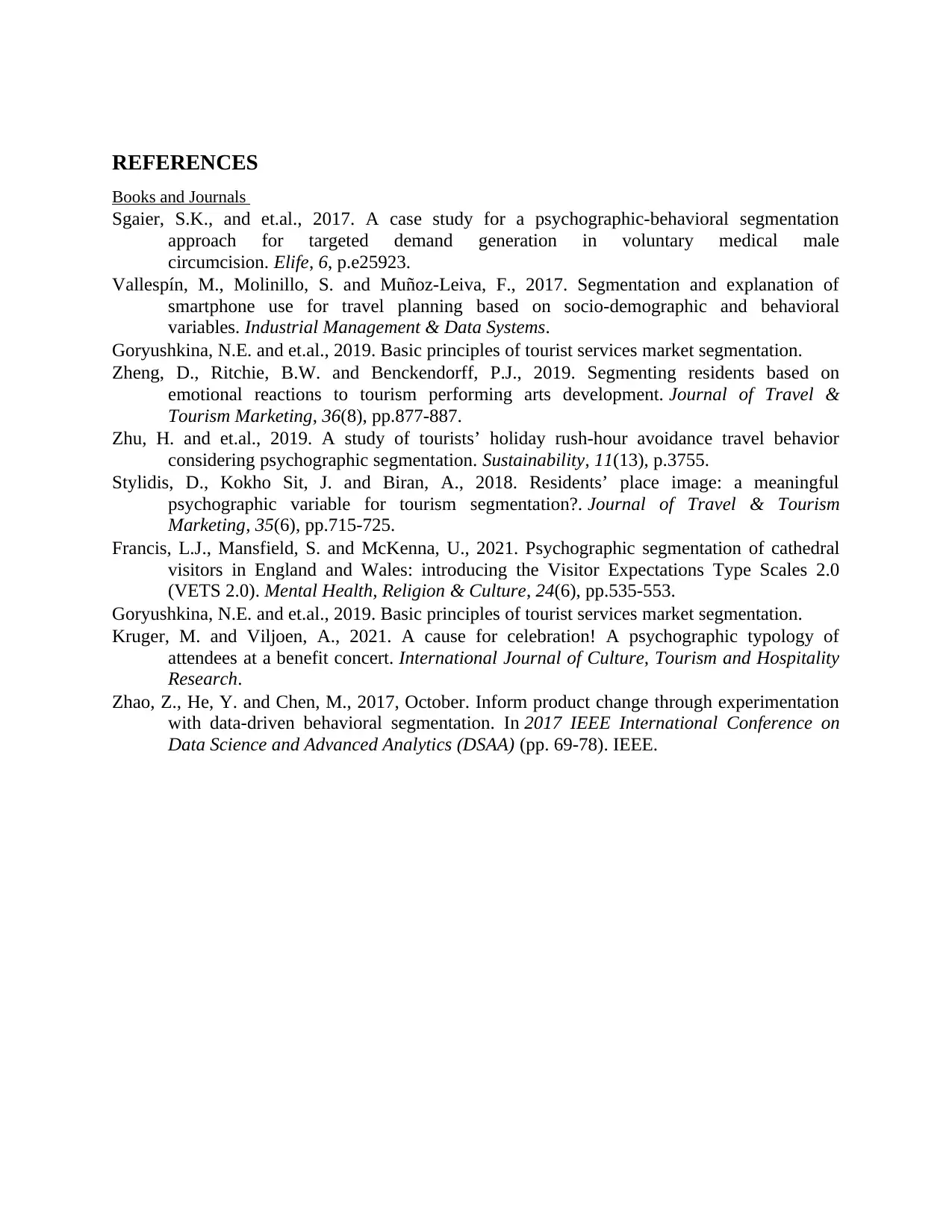
REFERENCES
Books and Journals
Sgaier, S.K., and et.al., 2017. A case study for a psychographic-behavioral segmentation
approach for targeted demand generation in voluntary medical male
circumcision. Elife, 6, p.e25923.
Vallespín, M., Molinillo, S. and Muñoz-Leiva, F., 2017. Segmentation and explanation of
smartphone use for travel planning based on socio-demographic and behavioral
variables. Industrial Management & Data Systems.
Goryushkina, N.E. and et.al., 2019. Basic principles of tourist services market segmentation.
Zheng, D., Ritchie, B.W. and Benckendorff, P.J., 2019. Segmenting residents based on
emotional reactions to tourism performing arts development. Journal of Travel &
Tourism Marketing, 36(8), pp.877-887.
Zhu, H. and et.al., 2019. A study of tourists’ holiday rush-hour avoidance travel behavior
considering psychographic segmentation. Sustainability, 11(13), p.3755.
Stylidis, D., Kokho Sit, J. and Biran, A., 2018. Residents’ place image: a meaningful
psychographic variable for tourism segmentation?. Journal of Travel & Tourism
Marketing, 35(6), pp.715-725.
Francis, L.J., Mansfield, S. and McKenna, U., 2021. Psychographic segmentation of cathedral
visitors in England and Wales: introducing the Visitor Expectations Type Scales 2.0
(VETS 2.0). Mental Health, Religion & Culture, 24(6), pp.535-553.
Goryushkina, N.E. and et.al., 2019. Basic principles of tourist services market segmentation.
Kruger, M. and Viljoen, A., 2021. A cause for celebration! A psychographic typology of
attendees at a benefit concert. International Journal of Culture, Tourism and Hospitality
Research.
Zhao, Z., He, Y. and Chen, M., 2017, October. Inform product change through experimentation
with data-driven behavioral segmentation. In 2017 IEEE International Conference on
Data Science and Advanced Analytics (DSAA) (pp. 69-78). IEEE.
Books and Journals
Sgaier, S.K., and et.al., 2017. A case study for a psychographic-behavioral segmentation
approach for targeted demand generation in voluntary medical male
circumcision. Elife, 6, p.e25923.
Vallespín, M., Molinillo, S. and Muñoz-Leiva, F., 2017. Segmentation and explanation of
smartphone use for travel planning based on socio-demographic and behavioral
variables. Industrial Management & Data Systems.
Goryushkina, N.E. and et.al., 2019. Basic principles of tourist services market segmentation.
Zheng, D., Ritchie, B.W. and Benckendorff, P.J., 2019. Segmenting residents based on
emotional reactions to tourism performing arts development. Journal of Travel &
Tourism Marketing, 36(8), pp.877-887.
Zhu, H. and et.al., 2019. A study of tourists’ holiday rush-hour avoidance travel behavior
considering psychographic segmentation. Sustainability, 11(13), p.3755.
Stylidis, D., Kokho Sit, J. and Biran, A., 2018. Residents’ place image: a meaningful
psychographic variable for tourism segmentation?. Journal of Travel & Tourism
Marketing, 35(6), pp.715-725.
Francis, L.J., Mansfield, S. and McKenna, U., 2021. Psychographic segmentation of cathedral
visitors in England and Wales: introducing the Visitor Expectations Type Scales 2.0
(VETS 2.0). Mental Health, Religion & Culture, 24(6), pp.535-553.
Goryushkina, N.E. and et.al., 2019. Basic principles of tourist services market segmentation.
Kruger, M. and Viljoen, A., 2021. A cause for celebration! A psychographic typology of
attendees at a benefit concert. International Journal of Culture, Tourism and Hospitality
Research.
Zhao, Z., He, Y. and Chen, M., 2017, October. Inform product change through experimentation
with data-driven behavioral segmentation. In 2017 IEEE International Conference on
Data Science and Advanced Analytics (DSAA) (pp. 69-78). IEEE.
1 out of 8
Related Documents
Your All-in-One AI-Powered Toolkit for Academic Success.
+13062052269
info@desklib.com
Available 24*7 on WhatsApp / Email
![[object Object]](/_next/static/media/star-bottom.7253800d.svg)
Unlock your academic potential
Copyright © 2020–2025 A2Z Services. All Rights Reserved. Developed and managed by ZUCOL.




